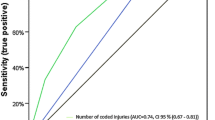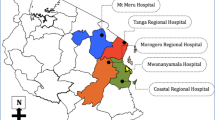Abstract
Background
The completeness of a trauma registry’s data is essential for its valid use. This study aimed to evaluate the extent of missing data in a new multicentre trauma registry in India and to assess the association between data completeness and potential predictors of missing data, particularly mortality.
Methods
The proportion of missing data for variables among all adults was determined from data collected from 19 April 2016 to 30 April 2017. In-hospital physiological data were defined as missing if any of initial systolic blood pressure, heart rate, respiratory rate, or Glasgow Coma Scale were missing. Univariable logistic regression and multivariable logistic regression, using manual stepwise selection, were used to investigate the association between mortality (and other potential predictors) and missing physiological data.
Results
Data on the 4466 trauma patients in the registry were analysed. Out of 59 variables, most (n = 51; 86.4%) were missing less than 20% of observations. There were 808 (18.1%) patients missing at least one of the first in-hospital physiological observations. Hospital death was associated with missing in-hospital physiological data (adjusted OR 1.4; 95% CI 1.02–2.01; p = 0.04). Other significant associations with missing data were: patient arrival time out of hours, hospital of care, ‘other’ place of injury, and specific injury mechanisms. Assault/homicide injury intent and occurrence of chest X-ray were associated with not missing any of first in-hospital physiological variables.
Conclusion
Most variables were well collected. Hospital death, a proxy for more severe injury, was associated with missing first in-hospital physiological observations. This remains an important limitation for trauma registries.

Similar content being viewed by others
References
Haagsma JA, Graetz N, Bolliger I, Naghavi M, Higashi H, Mullany EC et al (2016) The global burden of injury: incidence, mortality, disability-adjusted life years and time trends from the global burden of disease study 2013. Inj Prev 22(1):3–18
Mock C, Juillard C, Brundage S, Goosen J, Joshipura M, editors (2009) WHO Guidelines for trauma quality improvement programmes Geneva: World Health Organisation 2009
Dandona L, Dandona R, Kumar GA, Shukla DK, Paul VK, Balakrishnan K et al (2017) Nations within a nation: variations in epidemiological transition across the states of India, 1990–2016 in the global burden of disease Study. Lancet 390(10111):2437–2460
Organization WH (2010) Injuries and violence the facts. 2010 [cited 2017 20/4/17]; Available from: http://apps.who.int/iris/bitstream/10665/44288/1/9789241599375_eng.pdf
Moore L, Clark DE (2008) The value of trauma registries. Injury 39(6):686–695
Haider AH, Saleem T, Leow JJ, Villegas CV, Kisat M, Schneider EB et al (2012) Influence of the National Trauma Data Bank on the study of trauma outcomes: is it time to set research best practices to further enhance its impact? J Am Coll Surg 214(5):756–768
O’Reilly GM, Gabbe B, Moore L, Cameron PA (2016) Classifying, measuring and improving the quality of data in trauma registries: a review of the literature. Injury 47(3):559–567
Porgo TV, Moore L, Tardif PA (2016) Evidence of data quality in trauma registries: a systematic review. J Trauma Acute Care Surg 80(4):648–658
Ringdal KG, Lossius HM, Jones JM, Lauritsen JM, Coats TJ, Palmer CS et al (2011) Collecting core data in severely injured patients using a consensus trauma template: an international multicentre study. Crit Care 15(5):R237
O’Reilly GM, Jolley DJ, Cameron PA, Gabbe B (2010) Missing in action: a case study of the application of methods for dealing with missing data to trauma system benchmarking. Acad Emerg Med 17(10):1122–1129
Shivasabesan G, Mitra B, O’Reilly GM (2018) Missing data in trauma registries: a systematic review. Injury 49:1641–1647
Lefering R (2002) Trauma Score Systems for Quality Assessment. Eur J Trauma 28(2):52–63
MacLeod JBA, Kobusingye O, Frost C, Lett R, Kirya F, Shulman C (2003) A comparison of the kampala trauma score (KTS) with the revised trauma score (RTS), injury severity score (ISS) and the TRISS method in a ugandan trauma registry is equal performance achieved with fewer resources? Eur J Trauma 29:392–398
O’Reilly GM, Cameron PA, Jolley DJ (2012) Which patients have missing data? An analysis of missingness in a trauma registry. Injury 43(11):1917–1923
Collaboration A-ITS (2016) Australia–India Trauma Systems Collaboration. 2016 [cited 2017 20/4/17]; Available from: http://aitsc.org/
Mitra B, Mathew J, Gupta A, Cameron P, O’Reilly G, Soni KD et al (2017) Protocol for a prospective observational study to improve prehospital notification of injured patients presenting to trauma centres in India. BMJ Open 7(7):e014073
Synnot A, Karlsson A, Brichko L, Chee M, Fitzgerald M, Misra MC et al (2017) Prehospital notification for major trauma patients requiring emergency hospital transport: a systematic review. J Evid Based Med 10(3):212–221
Mitra B, Cameron PA, Fitzgerald MC, Bernard S, Moloney J, Varma D et al (2014) “After-hours” staffing of trauma centres and outcomes among patients presenting with acute traumatic coagulopathy. Med J Aust 201(10):588–591
O’Reilly GM, Joshipura M, Cameron PA, Gruen R (2013) Trauma registries in developing countries: a review of the published experience. Injury 44(6):713–721
O’Reilly GM, Cameron PA, Joshipura M (2012) Global trauma registry mapping: a scoping review. Injury 43(7):1148–1153
Newgard CD (2006) The validity of using multiple imputation for missing out-of-hospital data in a state trauma registry. Acad Emerg Med 13(3):314–324
Carr BG, Reilly PM, Schwab CW, Branas CC, Geiger J, Wiebe DJ (2011) Weekend and night outcomes in a statewide trauma system. Arch Surg 146(7):810–817
Ono Y, Ishida T, Iwasaki Y, Kawakami Y, Inokuchi R, Tase C et al (2015) The off-hour effect on trauma patients requiring subspecialty intervention at a community hospital in Japan: a retrospective cohort study. Scand J Trauma Resusc Emerg Med 23:20
Zehtabchi S, Nishijima DK, McKay MP, Clay Mann N (2011) Trauma registries: history, logistics, limitations, and contributions to emergency medicine research. Acad Emerg Med 18(6):637–643
Arts DG, De Keizer NF, Scheffer GJ (2002) Defining and improving data quality in medical registries: a literature review, case study, and generic framework. J Am Med Inform Assoc 9(6):600–611
Moore L, Hanley JA, Lavoie A, Turgeon A (2009) Evaluating the validity of multiple imputation for missing physiological data in the national trauma data bank. J Emerg Trauma Shock 2(2):73–79
Funding
The AITSC was funded by the Indian Government (Department of Science and Technology) and the Australian Government (Department of Industry, Innovation and Science), through the Australia-India Strategic Research Fund (AISRF), Grand Challenge Round 2, AISRF-GA12, Grant Number GCF0200130.
Author information
Authors and Affiliations
Consortia
Corresponding author
Ethics declarations
Conflict of interest
The authors declare they have no conflict of interest.
Ethics approval
Ethics approval for this study was granted by the Alfred Hospital Ethics Committee (Project 245/17), the Monash University Human Research Ethics Committee (CF16/1814 - 2016000929), and each hospital site in India (AIIMS—IEC/NP-327/2013; LTMG—IEC/83/14; VS—approved 13/11/2013; GTB—approved 12/2/2015).
Additional information
Publisher's Note
Springer Nature remains neutral with regard to jurisdictional claims in published maps and institutional affiliations.
Rights and permissions
About this article
Cite this article
Shivasabesan, G., O’Reilly, G.M., Mathew, J. et al. Establishing a Multicentre Trauma Registry in India: An Evaluation of Data Completeness. World J Surg 43, 2426–2437 (2019). https://doi.org/10.1007/s00268-019-05039-2
Published:
Issue Date:
DOI: https://doi.org/10.1007/s00268-019-05039-2




